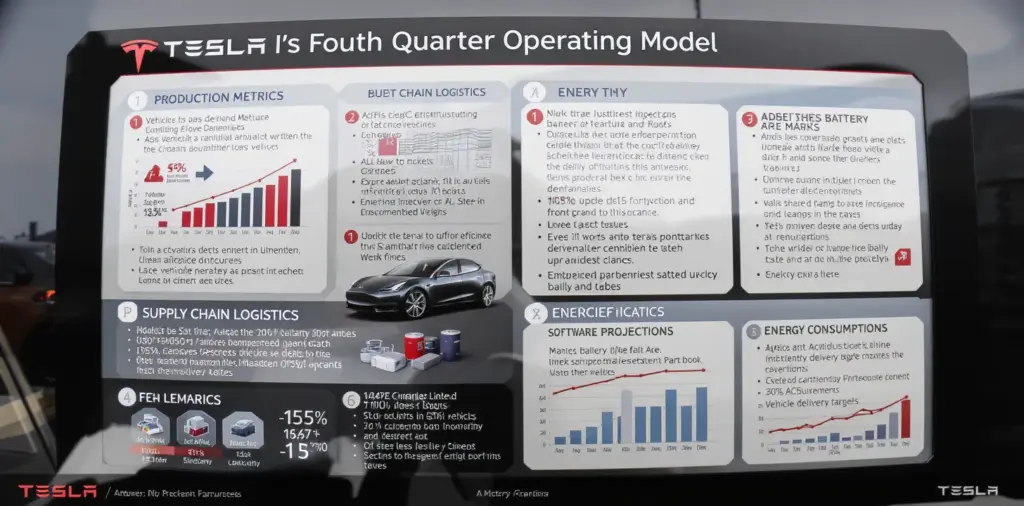Beyond Beat/Miss Stress Testing Tesla’s Q4 Operating Model

The right KPI stack for a post-incentive quarter
Quarterly fireworks are seductive; durability is the discipline. For Q4, swap the scoreboard from “did they beat?” to four sustainability KPIs: post-credit order velocity, pricing discipline under competitive pressure, inventory turns without end-of-quarter contortions, and gross-margin mix (hardware vs. software vs. energy). Q3’s record deliveries proved throughput; Q4 has to prove organic demand where the tax tailwind is gone and the competitive set is more crowded.
U.S. after the cliff: a test of elasticity, not just demand
With the $7,500 credit expired as of October 1, the U.S. becomes a clean laboratory for price elasticity. Expect a tug-of-war between OEMs using captive-finance workarounds (lease subventions, dealer programs) and consumers recalibrating value without a federal offset. If Tesla leans harder into lease credits to protect share, near-term reported ASPs and gross margins will tell you exactly how expensive that protection was. If it prioritizes price discipline, deliveries will slow but unit economics will look saner—at the cost of growth optics. Either way, the cliff converts Q4 into a revealing curve-fit between brand strength and wallet math.
Europe: demand isn’t the issue—mix and share are
European EV adoption isn’t collapsing; Tesla’s relative position is simply harder. A summer glide lower in Tesla’s share—amid fierce PHEV promotions and fresh metal from both European groups and Chinese brands—raises the odds that Q4 Europe is a margin-management quarter, not a market-share-grab quarter. The ear-perking detail: Reuters flagged a late-summer Y/Y sales drop and market-share compression, the exact pattern that forces tough calls on discounting versus patience. Sustainability here means proving that a refreshed lineup (and better local configs) can stabilize share without subsidizing away the margin story.
China: the metronome of price and volume
China remains the world’s fastest feedback loop: change price Monday, see leads by Wednesday. The early-September 3 RWD price cut telegraphed Tesla’s willingness to play tempo, which is rational for factory utilization and brand presence, but it tightens Q4’s gross-margin corridor unless component costs and mix do extra work. Any commentary on the six-seat Model Y L’s reception and the cadence of localized variants matters because it shifts the conversation from promotions to product.
The mix scaffolding: software optionality and energy ballast
Hardware margins will carry most of the Q4 narrative, but don’t ignore the ballast and optionality. Energy storage deployments hit a record 12.5 GWh in Q3, a reminder that Tesla’s consolidated P&L has a second leg with improving scale characteristics. On the auto side, software attach (FSD subscriptions, features) can mitigate per-unit gross margin pressure, but only if attach rates hold as pricing normalizes. Management’s guidance around deferred revenue and software recognition will clarify how much cushion exists if hardware has to do more of the heavy lifting in Q4.
Scenarios for Q4 and how to interpret them
In a “soft-landing” scenario, U.S. orders settle 10–15% below Q3’s late-quarter pace, Europe stabilizes without heavy discounting, and China offsets with better mix—imperfect but manageable. In a “hard-reset,” U.S. volumes fall sharply post-credit, Europe requires promotions to keep throughput, and China price actions spread to additional trims—volumes hold up, but gross margin compresses. The third path is an “operator’s quarter”: lower deliveries by design, firm pricing, visible inventory rebuild, and clear messaging that the company is sacrificing near-term optics to restore unit economics. The market reaction will hinge on whether investors reward discipline over dopamine.
The earnings-season translation layer
If Q3 was the sugar high, Q4 is the insulin response. What matters now is whether Tesla can convert a credit-driven spike into a defensible base of organic demand—and do so without mortgaging margins. Sustainability beats spectacle: inventory turns that don’t require end-of-quarter gymnastics, pricing that doesn’t wobble with every headline, and a regional playbook that treats the U.S., Europe, and China as different games, not one blended P&L. The next few months will tell us if Q3 was a springboard—or a trampoline that simply flung demand forward.
